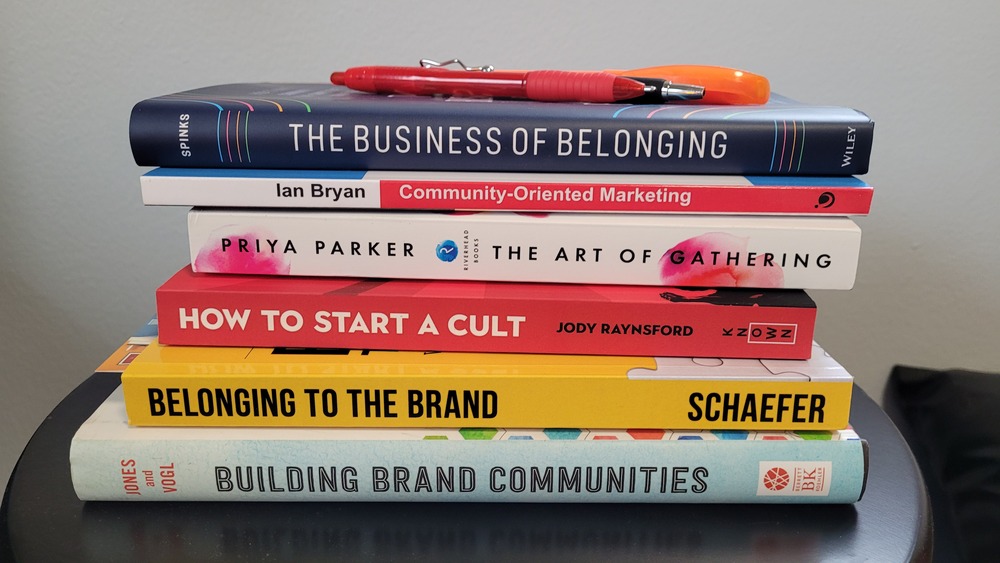My entire career has been spent in the realm of content creation, but I’ve been spent a lot of time lately immersed in community building. Perhaps this is a side effect of the COVID-19 pandemic lockdown; during that time, I found that I had no shortage of content to consume (Hello, Tiger King! 100% plus the DLC, Breath of the Wild!), but I was not getting my recommended daily dose of human interaction. Despite drastic improvements in our technology, Zoom hangouts and Discord chats just weren’t cutting it.
By the time I was finally able to go to my first conference after a year and a half of isolating, it was painfully obvious what I had been missing: a sense of community. I began to research the concept of community, particularly in relation to brands, and before long I found myself deep down the rabbit hole. Again, here’s the stack of books on my nightstand:

Misuse of the Word “Community”
The first thing I realized is how often the word “community” is misused. We are particularly guilty of this in the radio industry, where we tend to describe things that give off “a sense of community” as being an actual community. An email database is not a community; an Instagram following is not a community; a radio station’s audience is not a community. I wrote about the differences between an audience and a community in January of last year, so I was pleasantly surprised when I saw that Mark Schaefer named the second chapter of his 2023 book, Belonging to the Brand, “Audience vs. Community.” Great minds think alike.
In this chapter, he writes:
“There are three distinguishing features of a community compared to an audience or list of social media followers:
-
- Connection to each other.
- Purpose.
- Relevance.”
In Building Brand Communities, Carrie Melissa Jones and Charles H. Vogl offer a similar definition of “brand communities”:
“[A]n authentic brand community includes all of these elements:
-
- Members who share a mutual concern for one another’s welfare
- Members who share a connected identity founded in core value(s) and purpose
- Members who participate in share experiences reflecting shared value(s) and purpose”
Importantly, Jones and Vogl draw a distinction between an authentic community and a “mirage community”:
A mirage community is a group that aspires to form a community, and may even call itself a community, but lacks the fundamental elements that constitute a community. As a result, mirage communities fail to deliver positive and organizational benefits.
Many times, you can recognize them because participants will miss at least one of the three conditions that support meaningful and returning engagement:
-
- Freedom to say no to participation or membership
- Connection to other people
- Progress towards a purpose
Those listeners that were forced to join your email list for a chance to win Megan Thee Stallion tickets? Not a community because they were forced onto the list. Those listeners that donate $5 each month to your public radio station? Also not a community, because while they have the freedom to say no and they share a common purpose (supporting the station), they are not connected to each other in any meaningful way.
So say it with me now: An audience is not a community.
So what is a community?
After poring over all the literature, the simplest definition that I prefer is this: A community is a group of people who come together for a shared purpose. When thinking about the community that you want to build, I find this formula useful:
“We are a group of X who are gathering to do Y in order to accomplish Z.”
For example:
- “We are a group of local musicians who are gathering to learn together in order to further our musical careers.”
- “We are a group of broadcasting engineers who are gathering to speak to students in order to develop the next generation of engineers.”
One of the best real world examples I have seen of community comes from Podcast Movement, the podcasting conference that has successfully built a community of podcasters who gather to learn from each other in order to become better podcasters.
This, of course, is an abbreviated discussion of the definition of community. If you’d like a fuller meditation on the concept, I recommend reading Building Brand Communities, The Business of Belonging, or Belonging to the Brand.
What does a Community Manager do?

David Spinks, the author of The Business of Belonging, is the Cofounder of CMX, an organization of over 20,000 community professionals — people who have the job title of “Community Manager,” or at least the job duties typically associated with community managers. In an interview with Marsha Druker, host of the Create Community podcast, he explains that he started CMX in part so that community professionals could talk to colleagues who already understand what they do and why it’s important. “So, what exactly do you do?” is apparently a question that annoys community managers at a lot at cocktail parties.
Side Note: I highly recommend listening to Druker’s conversation with Spinks. It’s a good intro to the concept of community, and you’ll discover that Spinks’ career in community building had surprising origins: hardcore music and video games. (I wonder how far he got in Breath of the Wild!)
In 2019, Carrie Melissa Jones wrote in a blogpost for CMX, “The title ‘Community Manager’ really means nothing without context, as community roles vary so widely from company to company and team to team.” I found no shortage of definitions of “Community Manager” in my research for this blog post, but none of them fully satisfied me. So instead of cutting and pasting a dictionary definition, I think it’s helpful to return to the distinction between audiences and communities.
When you aim to attract an audience, you are creating content. That content could be a radio station, a television show, a film, a podcast, a book, or something else entirely. Audiences form because people enjoy consuming the content. As a content creator, you can talk to the audience, but for the most part, they don’t speak back to you in any meaningful way, and audience members certainly don’t communicate with each other. Program Directors, On-Air Talent, Show Runners, Movie Directors, Podcasters, Authors — these are all job titles for different types of content creators.
When you set out to build a community, you are creating a space. People gather in this space for a shared purpose. This space can be physical, virtual, or both. While content can play a role in building the space (for example, a conference will offer presentations or a LinkedIn group could feature articles), the content alone is not sufficient. The space must enable the members to connect with one another and progress towards their shared goal.
A Community Manager is the professional responsible for cultivating that space.
The specific tasks a Community Manager carries out will vary from situation to situation, but the key duties include:
- Growth: Getting people to join the community
- Gatekeeping: Making sure that only the right people are in the space
- Establishing the Culture: Setting the tone for the community by providing examples for others to follow
- Moderation: Instigating engagement between community members
- Enforcement: Ensuring the safety and civility of community members by enforcing the rules
- Measurement: Tracking metrics related to the growth and health of the community
If this sounds like it requires the same skills needed to be a great party host or wedding planner, that’s because it does. While the ability to create quality content can be very helpful, it is not the primary skill required. Often, there’s more overlap in the skills of a Community Manager and a radio station Promotions Director than overlap with the skills of on an on-air talent.
Community Managers vs. Social Media Managers
While it’s not uncommon for one person to be responsible for managing social media and online communities, it’s important to recognize the difference between these duties.
Jones and Vogl discuss the difference in Building Brand Communities:
Social media can be fantastic for promoting a community of event(s). But it’s lousy at knitting together relationships to create or deepen a community… To be effective leaders, we must distinguish between social media activity that promotes events and other meaningful engagement that knits community.
Tom Ross hosts Learn.Community, a community of community builders. Like CMX, it’s a fantastic resource for anyone looking for help from others who are also launching a community. In a recent discussion thread, a member asked about how changing attitudes towards social media might affect community managers, given that so much of what they do happens online. Do people conflate social media with communities? As negative sentiment towards social media grows, will people also start to reject online communities? Here was Tom’s response:
It’s not just attitudes towards social media that have changed; social media itself has changed. Last year, a column in The Atlantic pointed out that the original purpose of social media was to “to connect with friends and family.” But the rise of Instagram gave way to “a new era of ‘performance’ media, in which we create online [content] primarily to reach people we don’t know instead of the people we do.” In other words, while social media originally emphasized its social aspects, with the rise of Instagram and TikTok, it now places the emphasis on the features that come with more traditional media.
Put another way: Social media today is focused on building audiences through content, not building communities through spaces. It’s worth distinguishing between digital publishing tools — like Instagram, TikTok, YouTube, and WordPress — and digital tools that create spaces — like Slack, Discord, Zoom, and the Metaverse. Notably, Facebook and LinkedIn can do both; Facebook and LinkedIn groups build spaces, while the newsfeeds are focused on content.
These two trends — social media and community building — are moving in opposite directions. One is trying to help people reach more strangers, while the other is focused on creating smaller groups where people can develop meaningful relationships. One is about quantity; the other is about quality. While they can be weaved together in a coherent strategy, it’s important to recognize that they are on not the same thing. What makes a person good a social media may not make them good at community management, and vice versa.
Does Your Radio Station Need a Community Manager?
 The short answer is: It depends.
The short answer is: It depends.
Even though we all work in the radio industry, we are not all in the same business. If you work for a small broadcasting company that owns a few radio stations, your salespeople may sell against the behemoths, but that doesn’t mean that what is right for them is also right for you. Community building is a perfect example of this:
If my company owns hundreds of radio stations (many with syndicated shows) or if it has satellites that beam hundreds of channels across the nation, then I’m in the Audience business. I’m simply trying to reach as many people as possible and to provide that reach to my advertising clients. Building community takes a lot of resources and is difficult to scale. It probably doesn’t make sense for my company.
But if I work for a smaller broadcasting company, with a handful of stations that feature local on-air talent and have deep ties to the market, then I would give serious consideration to a community building strategy. Developing niche communities could open up new streams of revenue and provide new relevance to a medium that has faded in the public’s mind.
If I ran a stand-alone public radio station that relies on donations from listeners, I would invest heavy resources into community building. Not only does it represent my best path forward, but it falls directly in line with the mission of my organization.
Building community also falls squarely in line with the mission of Christian radio stations. If I were running one, I would definitely thinking about to incorporate community building tools and tactics into our daily routine.
Finally, if I had a niche podcast with a dedicated following, I would also spend a lot of time thinking about how to build a community around it.
Community Building at the NAB Show
On April 18th, I will be hosting a session called “Community Building Strategies for Broadcasters” at the NAB Show in Las Vegas. If you’re headed to Nevada, I hope to see you there!
- A Simple Digital Treat to Thank Your Radio Listeners This Thanksgiving - November 13, 2023
- Interview Questions When Hiring Your Radio Station’s Next Digital Marketing Manager - November 6, 2023
- A Radio Conversation with ChatGPT: Part 2 – Promotions - October 30, 2023





This is a good broad context for this type of position, Seth. Thanks for sharing it!